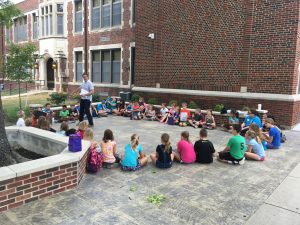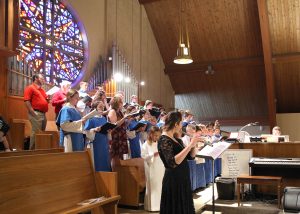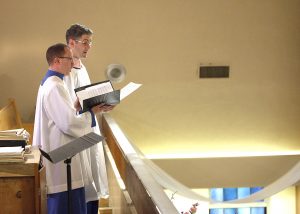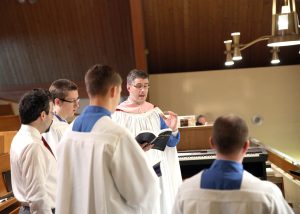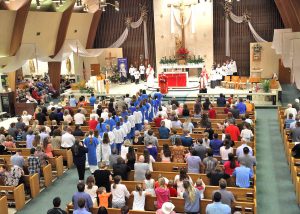“The Catholic liturgy is the supreme example of an objectively established rule of spiritual life. It has been able to develop… in every direction, and in accordance with all places, times, and types of human culture. Therefore it will be the best teacher of the via ordinaria–the regulation of the religious life in common, with, at the same time, a view to actual needs and requirements.” (R. Guardini, The Spirit of the Liturgy)
The great problem with the Universal Prayer of the Roman Catholic Church today is that for all practical purposes (speaking subjectively) it has ceased to be the Universal Prayer of the Roman Catholic Church. Those things that allowed the Mystical Body of Christ to worship as one family, transcending both the limitations of time and space, have been shoved aside if not outright discarded. It amazes me that within living memory the average Catholic could travel anywhere in the world in which the Latin Rite was celebrated, trusty hand missal in tow, and pray the Mass, even in foreign lands. The homily might have been in a different language or the Mass might have had a certain European, American, African or Asian feel, depending upon where one found oneself on Sunday morning, but the differences were rather minor–but no more.
Contrast this with the experience of typical Catholics today, who go to Mass in their own state or country and wonder if they still inhabited the same planet, much less attend the same Mass. Anymore, the Holy Sacrifice has taken on the fluidity of one’s gender. What, you don’t like it? Just change it and make it whatever you want it to be! Admittedly, the experimentation is NOT what it was in the 70s, nevertheless, the mentality exists that the Sacred Liturgy can be adapted and personalized in an almost unlimited number of ways.
Our liturgical problem is really symptomatic of a much deeper problem, the loss of Faith in Christ and in His Church (really the two problems are deeply connected). Thankfully I meet more and more young people who are seriously embracing Faith in Christ and the Church. As they do so, they are discovering the great cultural riches of the Church, whether in Her Liturgy or prayer life, the lives of Her saints or in Her moral life. This group of people is by no means a majority, but it is a strong and vibrant minority. I also see holy priests coming from among them, and Deo gratias for that.
Young people today aren’t yearning for the ancient expressions of the Church’s liturgical life merely due to a distorted view of a supposedly golden former age, but because their very souls and their humanity need these things to pray in the first place. Young people are mired in individualism and simply handing out more of it in the form of giving them “what they want” is not going to bring them to Christ. Rather, the answer lies in uniting them to the universal, to what is True, Beautiful and Good–to God; uniting them to the Church Militant, the Church Suffering and the Church Triumphant. The Sacred Liturgy used to have the power to do this (again, subjectively speaking).
What follows is a very simplistic list, in no particular order, of some of the externals in the Church’s liturgical life that had the power to draw the believer out of his own little kingdom and into the universal family of the Church. Would that return sooner rather than later.
- The beauty of a common, sacral language. Whether you like to admit it or not, the Latin Rite was formed by the Latin Language, which provided a basis for communication for Catholics across the globe, and the loss of that language and the communication it allowed has proved a travesty. The fact that the majority of fathers at the Second Vatican Council could communicate with each other reasonably well, not withstanding such diverse backgrounds, was a minor miracle. Latin Rite Catholics could take part in the Mass or Divine Office wherever they found themselves and Latin provided the sacred vehicle for that prayer, removed from the vulgarities of everyday speech. Interestingly, the Latin, via beautiful translations, supported and shaped sacral speech in the vernacular. Now each Catholic is marooned on his own linguistical island, islands which tend to be culturally impoverished and bereft of any beauty. I chuckle when I pray the Gloria using inclusive language (peace to his people on earth) but then switch to “sexist” language in the Creed (and became man). Then there are the Responsorial Psalm antiphon translations, which don’t match the translations of the psalms themselves because each one was translated from different different versions of the scriptures. And these problems pale in comparison to the general tone of the English texts–common, common, common. One would think the translators despised beauty and poetry altogether, although what we currently have is infinitely superior to what we had 10 years ago.
- The priest visibly standing in the Sacred Liturgy in persona Christi. Quite frankly, it shouldn’t matter if the celebrant is “Faaaather Bowwwb.” or HE, the Cardinal Archbishop of such and such… They and their personalities shouldn’t matter–it is Christ Who matters. Why have we allowed the regrettable “tradition” of naming all of the participants in a particular “liturgy?” “…Our celebrant for this liturgy is Faaaaather Bowwwwb; our lectors are Mary Smith and Jane Thomas; our servers are Jane Smith, Lucy Jones and Samantha Jones; our Eucharistic Ministers are Helen Quick, Nancy Slow, Marcia High and Janet Low; our musicians are terrible, oh I mean Mary Right and Kenny Wrong; our ushers are ……….” (All joking aside, I have experienced this in real life.) On and on and on. I don’t know any of them, and quite frankly it wouldn’t matter if I did. It isn’t about the priest, the “ministers” or me–not in that sense. It is about God. The habit of naming everyone physically taking part in Mass belies the assumption that the priest is an MC whose job it is to stir up good vibes among those “assembled” instead of another Christ, offering Himself to the Father through the Holy Spirit. I can’t imagine Christ having worried about stirring up good vibes in the apostles at the Last Supper. Christ, as head of the Mystical Body of Christ, focused on the Father, which provides an excellent segue into plea for worshipping ad orientem. There is no reason for me to keep beating the horse here, but I firmly believe that the simple act of facing east would probably do more than anything in the Novus Ordo to reverse the travesty of Mass being about the priest and people rather than about God.
- A classical (and shared) view of what constitutes Christian architecture, art and music. In times past one could visit the city of Cincinnati or Tokyo, it wouldn’t matter, and make an educated guess at which buildings were Catholic Churches (or at least churches) and which ones weren’t. Christians shared a common symbolic language in their architecture and art. The same could be said for music, but in the rush to be relevant (to society, but not, ironically, to God) we have jettisoned much of what is beautiful in Catholicism and replaced it with what is fashionable.
- A rich life of piety and Christian Community. In former times, families came together daily to make the Morning Offering and to pray the Rosary, parishes hosted processions, novenas and May crownings, people sang hymns in their homes and young people formed dance bands and played for their friends on Saturday nights at the local barn or community hall. That is all gone now and we shove everything, even the Sacraments, from Weddings and Confirmations to Baptisms and Anointings, into the Mass. On the flip side, the Church has tried to make all devotions outside of Mass conform to the Liturgy of the Word, complete with readings and petitions. No wonder many cultural Catholics think the Mass is all that’s left, so they shove evening thing into it, from the band they formed to the pop music they like to the Sacraments and many other more or less important life events. The richness of the Divine Office (the other part of the Sacred Liturgy) and Benediction, which found a home in so many normal parishes prior to the 1960s have been forgotten. All this means that the Universal Prayer of the Church, Her Sacred Liturgy, must be adapted to every situation, whim or need of a particular church and its members. No wonder so many people leave Mass early. If you aren’t from such and such parish or if the menagerie of speakers who stroll into the sanctuary at the end of Mass to talk about this or that don’t touch on what’s important to you, why stay to the end for an extra 10 minutes of irrelevant community announcements.
I would like to end where I began, with Gaurdini. He writes “The primary and exclusive aim of the liturgy is not the expression of the individual’s reverence and worship for God. It is not even concerned with the awakening, formation, and sanctification of the individual soul as such. Nor does the onus of liturgical action and prayer rest with the individual. It does not even rest with the collective groups, composed of numerous individuals, who periodically achieve a limited and intermittent unity in their capacity as the congregation of a church. The liturgical entity consists rather of the united Body of the faithful as such–the Church–a body which infinitely outnumbers the mere congregation.
I don’t hope or even desire that every Mass be exactly the same, but I should be able to experience the reality of the Mystical Body of Christ instead of banging my individualism up against someone else’s. This is something I hope we can all pray for.


